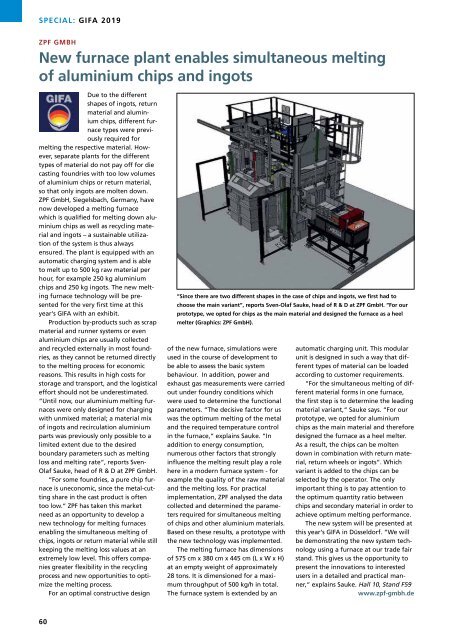CPT International 02/2019
- No tags were found...
Create successful ePaper yourself
Turn your PDF publications into a flip-book with our unique Google optimized e-Paper software.
SPECIAL: GIFA <strong>2019</strong><br />
ZPF GMBH<br />
New furnace plant enables simultaneous melting<br />
of aluminium chips and ingots<br />
Due to the different<br />
shapes of ingots, return<br />
material and aluminium<br />
chips, different furnace<br />
types were previously<br />
required for<br />
melting the respective material. However,<br />
separate plants for the different<br />
types of material do not pay off for die<br />
casting foundries with too low volumes<br />
of aluminium chips or return material,<br />
so that only ingots are molten down.<br />
ZPF GmbH, Siegelsbach, Germany, have<br />
now developed a melting furnace<br />
which is qualified for melting down aluminium<br />
chips as well as recycling material<br />
and ingots – a sustainable utilization<br />
of the system is thus always<br />
ensured. The plant is equipped with an<br />
automatic charging system and is able<br />
to melt up to 500 kg raw material per<br />
hour, for example 250 kg aluminium<br />
chips and 250 kg ingots. The new melting<br />
furnace technology will be presented<br />
for the very first time at this<br />
year‘s GIFA with an exhibit.<br />
Production by-products such as scrap<br />
material and runner systems or even<br />
aluminium chips are usually collected<br />
and recycled externally in most foundries,<br />
as they cannot be returned directly<br />
to the melting process for economic<br />
reasons. This results in high costs for<br />
storage and transport, and the logistical<br />
effort should not be underestimated.<br />
“Until now, our aluminium melting furnaces<br />
were only designed for charging<br />
with unmixed material; a material mix<br />
of ingots and recirculation aluminium<br />
parts was previously only possible to a<br />
limited extent due to the desired<br />
boundary parameters such as melting<br />
loss and melting rate“, reports Sven-<br />
Olaf Sauke, head of R & D at ZPF GmbH.<br />
“For some foundries, a pure chip furnace<br />
is uneconomic, since the metal-cutting<br />
share in the cast product is often<br />
too low.“ ZPF has taken this market<br />
need as an opportunity to develop a<br />
new technology for melting furnaces<br />
enabling the simultaneous melting of<br />
chips, ingots or return material while still<br />
keeping the melting loss values at an<br />
extremely low level. This offers companies<br />
greater flexibility in the recycling<br />
process and new opportunities to optimize<br />
the melting process.<br />
For an optimal constructive design<br />
“Since there are two different shapes in the case of chips and ingots, we first had to<br />
choose the main variant“, reports Sven-Olaf Sauke, head of R & D at ZPF GmbH. “For our<br />
prototype, we opted for chips as the main material and designed the furnace as a heel<br />
melter (Graphics: ZPF GmbH).<br />
of the new furnace, simulations were<br />
used in the course of development to<br />
be able to assess the basic system<br />
behaviour. In addition, power and<br />
exhaust gas measurements were carried<br />
out under foundry conditions which<br />
were used to determine the functional<br />
parameters. “The decisive factor for us<br />
was the optimum melting of the metal<br />
and the required temperature control<br />
in the furnace,“ explains Sauke. “In<br />
addition to energy consumption,<br />
numerous other factors that strongly<br />
influence the melting result play a role<br />
here in a modern furnace system - for<br />
example the quality of the raw material<br />
and the melting loss. For practical<br />
implementation, ZPF analysed the data<br />
collected and determined the parameters<br />
required for simultaneous melting<br />
of chips and other aluminium materials.<br />
Based on these results, a prototype with<br />
the new technology was implemented.<br />
The melting furnace has dimensions<br />
of 575 cm x 380 cm x 445 cm (L x W x H)<br />
at an empty weight of approximately<br />
28 tons. It is dimensioned for a maximum<br />
throughput of 500 kg/h in total.<br />
The furnace system is extended by an<br />
automatic charging unit. This modular<br />
unit is designed in such a way that different<br />
types of material can be loaded<br />
according to customer requirements.<br />
“For the simultaneous melting of different<br />
material forms in one furnace,<br />
the first step is to determine the leading<br />
material variant,“ Sauke says. “For our<br />
prototype, we opted for aluminium<br />
chips as the main material and therefore<br />
designed the furnace as a heel melter.<br />
As a result, the chips can be molten<br />
down in combination with return material,<br />
return wheels or ingots“. Which<br />
variant is added to the chips can be<br />
selected by the operator. The only<br />
important thing is to pay attention to<br />
the optimum quantity ratio between<br />
chips and secondary material in order to<br />
achieve optimum melting performance.<br />
The new system will be presented at<br />
this year‘s GIFA in Düsseldorf. “We will<br />
be demonstrating the new system technology<br />
using a furnace at our trade fair<br />
stand. This gives us the opportunity to<br />
present the innovations to interested<br />
users in a detailed and practical manner,“<br />
explains Sauke. Hall 10, Stand F59<br />
www.zpf-gmbh.de<br />
60

















